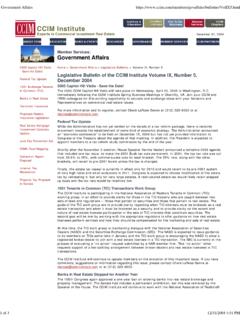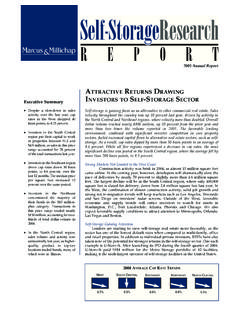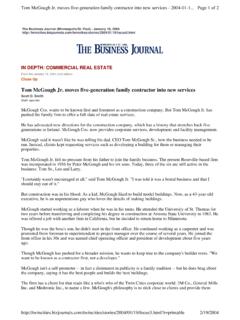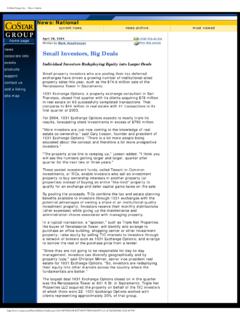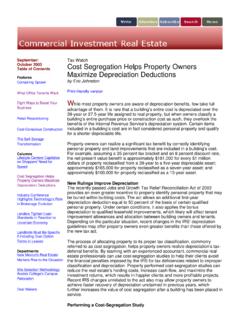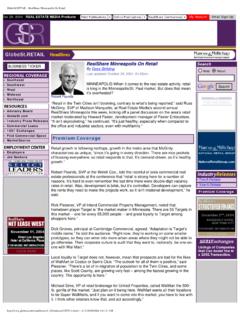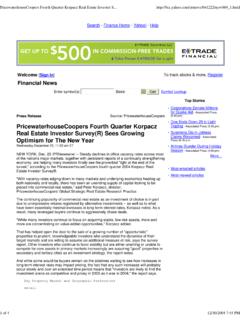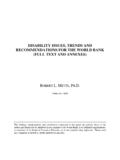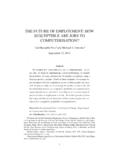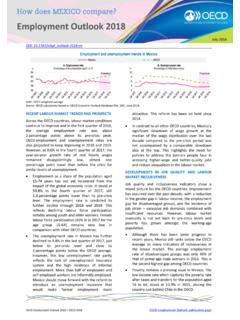Transcription of Forecast 2006: Five trends driving the industry - …
1 Forecast 2006 : five trends driving the industry Written by Matt Hudgins Dec 1, 2005 12:00 PM. While mounting pressures may produce cracks in the economic recovery in 2006 , the nation is on track to close out 2005 on a resilient note. Real GDP growth in the third quarter was higher than expected at an annualized rate of The economy has so far withstood the energy price shock and some major natural disasters, yet continues to perform very well, says Hessam Nadji, managing director of research services at Marcus & Millichap.
2 Despite economic expansion, interest rates have remained low by historical standards, fueling what Nadji says will be record investment activity in 2005. More than $71 billion of properties sold in the third quarter a quarterly record bringing the year-to-date total to nearly $190 billion, according to Real Capital Analytics. Some experts take a more critical view of 2005, however, noting disturbing investment patterns that seem to disregard risks in an economy under increasing strain. 2005 is probably best characterized by a lack of discipline in the market, says Ken Munkacy, COO of New Boston Fund.
3 Hurricane Katrina is almost a metaphor for our industry . The sort of irrational exuberance that Alan Greenspan spoke about years ago has pretty much reached tsunami levels, adds Munkacy. Boston- based New Boston Fund is a private real estate firm that owns and manages more than 13 million sq. ft. of commercial real estate valued at more than $ billion. The cumulative effects of hurricane damage, war, high energy prices, capital market volatility and overbuilding in some sectors are all warning signs. Those things bring stress to the economy, and that will eventually lead to distress, maybe in the third or fourth quarter of 2006 , says Munkacy, who expects to see increasing loan failures next year, particularly in overbuilt condominium markets.
4 What will be the greatest sources of economic stress in the coming year, and how will those forces affect the economy and shape demand for commercial real estate? NREI takes a look at five hot-button issues for 2006 . Rising energy, construction costs 1. Although fuel prices fell throughout November, they remain high by historical standards. In mid-November, the price of gasoline was cents per gallon higher than a year ago, and diesel fuel was up 47 cents for the same period, according to the Energy Information Administration.
5 Even before Hurricane Katrina, construction costs were climbing due in large part to demand for materials from China and India. The price of steel pipe shot up from July 2003 to July 2004, and edged up another in 2005, according to The Associated General Contractors of America. Additional increases stemming from rebuilding along the Gulf Coast won't be felt until 2006 . The biggest thing affecting the industry in 2005 has been construction costs. It's been outrageous, says Joe Faulkner, executive managing director of brokerage services in the Los Angeles office of Charles Dunn Co.
6 , a full-service commercial real estate firm. In the aftermath of the 2005 hurricane season, experts expect rebuilding efforts and the loss of some production facilities to keep prices high well into 2006 for concrete, gypsum and other construction materials. The cost of materials is climbing about 1% each month in New England, and in Florida materials today cost 25% to 30% more than they did a year ago, says Jim Kelleher, senior vice president and director of acquisitions at New Boston Fund. An office building we built for $210 per sq.
7 Ft. in the Washington, suburbs five years ago would cost us $330 per sq. ft. to build today as a result of drastic price increases, Kelleher says. Fuel costs increase the price tag for shipping virtually everything and will squeeze consumers and businesses alike with higher heating bills this winter. In the Northeast, the price of oil will be 30% to 50% higher this winter than it was a year ago and propane prices may be as much as 100% higher for the same period, Munkacy projects. Economists say high prices for both energy and construction materials are a short-term problem, however, and new sources of commercial construction materials will slow the rise in prices, or even begin to bring prices down before the end of 2006 .
8 China, for example, is beginning to produce concrete reinforcing bar and other building materials it previously only purchased, says Jim Costello, senior economist at Boston-based Torto Wheaton Research. While Costello doesn't believe high construction costs discourage new development, he says that rising costs will encourage some developers to convert well-located office stock to other uses, such as retail, residential or mixed use. The relatively high cost of interior finishes means tenants may favor completed offices over shell space in 2006 , says Michael Silver, president of Chicago-based Equis Corp.
9 , a real estate services provider. The exception will be new, highly efficient space that may offset the cost of interior construction, he says. Of greater concern to investors may be the effect of high energy bills on consumers, says Doug Duncan, chief economist of the Mortgage Bankers Association. That's one reason the MBA expects mortgage delinquencies to increase in 2006 . When home heating costs rise, consumers faced with a choice of making a mortgage payment on time or heating the house will heat the house.
10 Waning consumer spending 2. In the past four years, mortgage refinancing has given homeowners, on average, a 25% increase in disposable income without a corresponding wage increase, says Dr. Rajeev Dhawan, director of the Economic Forecasting Center at Georgia State University. Entering 2006 , however, rising interest rates threaten to halt the spending spree. The danger zone is if this 10-year Treasury bond yield is 6% by mid- 2006 , then the consumer will run out of cash from his housing- equity ATM before job growth replenishes the coffers.
